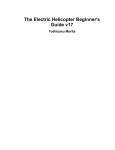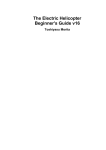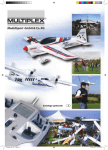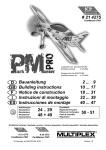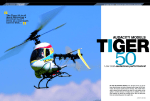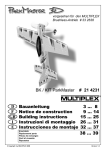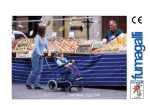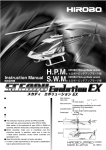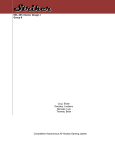Download June 2005 MHW - Audacity Models
Transcript
TIGER 50 (JUNE '05) 4/14/05 12:59 PM Page 70 Feature The Tiger 50 is a stable sport helicopter and well suited for beginners. When implemented with the adjustments and 3-D set up described in the text it becomes a spirited 3-D trainer Tiger 50 An in-depth look at Audacity Models Tiger 50 words: Tom Scully, photos: Tom Scully and James Wang ello everyone, I've done a lot of travelling since last time and I am glad to be back and flying again. This month we look at a 50-class helicopter newly presented to the market by Audacity Models and it is called the Tiger 50. Regulars will recall Richard Morris reviewed the robbe Ornith in the October 2003 MHW and may think it looks familiar, but as it turns out, the Tiger 50 offers many improvements. Though the same company also OEMs the Tiger 50, they do so to Audacity’s specifications and what results is as distinct as Stevenson’s Dr. Jekyll from Mr. Hyde. In short, while the Ornith is a mellow and stable helicopter with which to perform basic loop and roll manoeuvres; Audacity fed the Tiger 50 some more testosterone. While it can be tamed for beginners, in the hands of 3-D pilots the Tiger 50 can perform Death Spirals, Tick-Tocks and Pirouetting Flips, etc. Audacity Models/Genesis Hobby Distributor is based near Disney World in Orlando, Florida in the USA. They are the exclusive distributor H The Tiger 50 is available in kit form or in ARF (almost ready to fly) as shown here 70 MHW June 2005 for the Americas (Canada, USA, Mexico and South America) as well as the UK, South Africa, Australia and New Zealand. Audacity’s crew on the other hand seem to be modellers first and businessmen second. They laughed when I asked why the Tiger 50 wasn’t released sooner and said, “We really abused the Tiger 50 and also destroyed several beyond repair. Then we’d fix it and fly it some more!”. Audacity says rather than rush to market, they subjected the Tiger 50 to a rigorous and intensive R&D effort and have been flying the stink out of it just to see what breaks for more than a year. This process resulted in somewhat extensive (though occasionally subtle) changes and they go far beyond merely re-christening it the Tiger 50 and making a new decal set. Ultimately, I found the Tiger 50 well suited for 3-D pilots searching for a ‘beater’ with which to practice manoeuvres before risking their more expensive helicopter. Tiger 50 Description I purchased the ARF version ($299.99 in the USA) primarily to save building time and it arrived in 30" x 16" x 10" box. After getting to know my Tiger 50, I subsequently purchased a kit version ($284.99), which arrived in a slightly more compact 30" x 16" x 8" box. The Tiger 50 is a fun helicopter; repair parts are inexpensive and the design is so simple that repairs are easy. This encourages me to attempt more manoeuvres - which I suspect is what Audacity had in mind all along. Out of the box, the mainframe and main rotor head are assembled as a unit. The tail rotor and tail boom are also an assembled unit. Even the landing gear is Minimal parts count. Notice the fuel line comes out though a keyhole in the right side-frame. Pulling the fuel line forward shuts off the fuel flow. This built-in feature eliminates the need for a fuel shut off valve. All plastic framed helicopters should have such a feature already assembled. While I took 30 minutes to add the landing gear, plug in the tail boom, slip the belt over the pulley and then bolt on the tail boom steadies and fins, this included time looking over the manual. Next I installed the fan and clutch to the engine, bolted it to the engine mount and after a quick session with the dial indicator slipped it into the model. Installing the servos, adding balls to the servo arms and sub trimming the servos didn’t take long. I was pleasantly surprised to discover the heavy duty prefabricated 2.3 mm diameter pushrods (with ball links installed at both ends instead of Zbends at the servos) resulted in my being ready to program the model very quickly. By the time I trimmed the canopy and added the decals I had spent perhaps 8 hours - but this included time for making notes. The kit takes more like 20 hours to complete. Balance the cost versus the pleasure and make your choice. You may be interested in knowing I went through each and every bolt of my ARF with an Allen driver and confirmed they were all tight. I even removed the two setscrews securing the tail rotor hub onto the tail output shaft to confirm thread locker was used in the factory assembly. The ARF workmanship is better than that of average novice modellers and in fact, Prototype electric Tiger 50 does not have an engine start shaft so the front servo can be located beneath the swashplate. The aluminium side frames are for testing only, eventually plastic frames will be made. The model will use 600 mm blades and similar in size and weight as the Logo 20. No word on when the electric version will be out TIGER 50 (JUNE '05) 4/14/05 12:59 PM Page 71 Tiger 50 Tiger 50 mechanics, note the exposed engine heat sink head the workmanship is more on par with what would be expected from a careful helicopter modeler with 3 to 5 years experience. Whoever built these ARF models spends every day doing it and is obviously quite expert as their methodology and assembly skill are consistent. After 40 flights on one Tiger 50, nothing has loosened up. A nice touch is the Tiger 50 features 3 mm Allen-head bolts throughout instead of cheaper crosshead Phillips screws. This is a definite plus with me because they don’t slip as easily as the Phillips do and I prefer Allen head bolts everywhere. For example, on my Freya 60 I replaced the four crosshead bolts that clamp the tail boom with four 3 mm Allen bolts. Long ago I also invested in a good quality set of hardened-tip Allen drivers with handles. Unlike L-shaped Allen wrenches, the hardened-tip Allen drivers are less likely to round out the hex socket of an Allen head bolts. Tiger Detail Like many of you, we have occasionally furrowed our brow wondering what helicopter manual writers had in mind, so as usual we first turned to the Tiger’s manual. It is quite obvious the Tiger 50 manual has been authored in English and is both fairly detailed and includes many nifty ‘Pro Tips’. Native speakers of the Queen’s English will have no difficulties. Noteworthy changes from an Ornith are found in the areas of the tail, the head, cyclic controls, side frames and the power train. Seemingly, the whole thing has been revised. Examples of changes in the model abound; let’s begin with the tail. Audacity Models specified a larger and beefier steel tail rotor hub (AH-0520) that is 2 mm larger in OD than that found on the Ornith. This isn’t a big deal unless a model spits the whole thing off which, of course, requires a successful autorotation to prevent destruction. To encompass new, longer (600 mm) main rotor blades (AH-1519), the tail boom (AH-1518) is longer, as is the tail drive belt (AH-0508). Another modification, to increase the speed of the tail rotor, results in a different front tail belt pulley (AH-0502) assembly. Let’s move to the head. Unnoticed by the naked eye, the main rotor grips (AH-0546) have a higher glass fibre content that increases their strength and keep them from prematurely wallowing out from hard use. Furthermore, and in keeping with the spirited nature of the class of manoeuvres Audacity anticipate Tiger pilots will subject their models to, thrust bearings (AH-1506) are specified. The Tiger 50 blade spindle diameter is 5 mm, which is the same as the Hirobo Shuttle and Raptor 30/50 V1, while the Evo 30/50 and Raptor 30/50 V2 use 6 mm spindles. However, Audacity maintains the 5 mm spindle will reduce collateral damage from a crash: the 5 mm spindle will be the sacrificial part instead of the rotor head parts. There is merit in this because at $5.92 (US hobby store cost), the spindle shaft is very inexpensive, however an optional 6 mm spindle kit (AH0516) is available. Furthermore, while both the Ornith and the Tiger 50 use 70 Durometer rubber dampers for main rotor blade spindle restraint to provide tighter control. In addition, there are optional bright yellow urethane 80 durometer (harder) dampers (AH-0518) available. This makes it very easy to fine tune the model to your liking. The Tiger 50 hovers and feels very smooth in flight - almost like an FAI-type helicopter and its tamed nature makes it well suited for novices, but to make it a wild 3-D ship requires different adjustments and I will detail these next. It’s unusual to find these adjustable capabilities in one machine; much less at a price point encroaching on 30-class helicopters. The sports set up configuration leads one to great confidence in circuit flying because like a fixed wing pattern aeroplane, in fast forward flight the Tiger 50 tracks very true, i.e. without a strong ‘pitch up’ tendency. Make a few field adjustments and the Tiger 50 can become a 3-D trainer. As mentioned, the Tiger 50 is a very adjustable helicopter. This is important because it permits the pilot to tune the Tiger to their preferred style of flight. Let’s examine the changes that resulted to the Tiger 50 control The engine, servos and all bearings are embedded on two moulded side frames. Very convenient, but if any area of the frame is cracked after a crash, the entire mechanics must be taken apart and rebuilt All 3 eCCPM servos mount directly to the plastic side frame. Fore/aft cyclic servo on the front and two roll servo beneath the main shaft. Notice the pulley and pinion for the belt drive tail rotor system Conventional floating axle main rotor and straight forward 120º electronic CCPM control system with direct pushrod link between roll servos and swashplate. The main gear drives the pinion and pulley for the belt drive tail rotor. CSM 200 gyro tested here June 2005 MHW 71 TIGER 50 (JUNE '05) 4/14/05 1:00 PM Page 72 Feature Two plastic mounting plates are used for each servo; the Tiger 50 comes with improved back plates that will not slide sub-system that make it so readily adjustable. For example, to tame the model down, a beginner may add the supplied lead rod to the leading edge of the hollow flybar paddles and perhaps move the ball in one hole on the washout arms. The 3-D maven will wish to go in the opposite direction. The Audacious crew’s R&D also developed a different seesaw (AH0548) with provisions for adjustable Bell-Hiller ratios. The revised seesaw features two Bell-Hiller ratios instead of one, novice and intermediate pilots will leave the ball in the outer position, resulting in a 1:1 (100%) Bell-Hiller ratio. Pilots seeking to practice 3-D manoeuvres will prefer the faster 0.7:1 (70%) Bell-Hiller ratio. Experienced modellers know a flybar functions like a mechanical rate gyro to help stabilise helicopters pitching and rolling motions. When a numerically lower ratio flybar tilts, there is less main blade pitch angle change, so reducing Bell-Hiller mixing ratios are similar to lowering the ‘gain’ setting on a gyroscope. The frugal amongst us will undoubtedly think simply drilling new holes in an Ornith seesaw accomplishes the same thing. That’s true, but don't do it because as with the main blade grips, the new seesaw also has higher glass fibre content, and there are moulded in reinforcing bosses as well. These greatly increase the strength where the ball screws in. There are other helicopters on the market that permit pilots to choose different Bell-Hiller mixing ratios to suit varying flying requirements. High end helicopters like the X-Cell and Fury models manufactured by Miniature Aircraft use different length steel ball studs on the Bell-Hiller mixing arm attached to the blade grip. Hirobo’s Freya and Evo, as well as Thunder Tiger’s Raptor 90, are similar to the Tiger 50 because they use additional pivoting position for the Bell-Hiller mixing arm to vary the Bell-Hiller mixing ratio. This is advantageous because the arm can be easily moved at the field without need for additional parts. The ball placement at the inner ring of the swashplate also affects the control feel of the model. The Tiger 50 includes two 12 mm x 2 mm bolts and two 3 mm x 2 mm i.d. bushings for moving two of the control balls on the swashplate further out. On the inner ring of the swashplate there are four control balls. The two balls that are further out are connected to the 72 MHW June 2005 The model uses 6 mm hex starting system, which is similar to many popular helicopters. Futaba GY240, GY-401 and CSM 200 gyros were tried, see text for result. Mount the gyro on the front to alleviate tail heaviness washout arms. The two balls that are closer in are connected via long pushrods to the BellHiller mixing arms. Adding the bushings move these two balls further out resulting in a longer lever giving greater main rotor blade angle change as the swashplate tilts (this is Bell command) which is often just what a 3-D pilot is seeking. Moving on to the frame, Audacity soon discovered that what works quite well in chilly Nova Scotia will be utterly inadequate during the sweltering summers of Texas or Florida. As The plastic clamp for the tail boom supports and for mounting the horizontal fin. It would have been even better if the two 3 mm bolt for the clamp were tightened from below then the horizontal fin does not need to be removed The stock paddle has a hole in the leading edge for inserting lead weight. Only total beginners should use the lead weight because even without the lead, the helicopter is very stable and the cyclics are not fast enough for aggressive 3-D. Need to buy lighter paddles and a threaded 3 mm flybar to speed up cyclic for 3-D flying Throttle linkage shown here. The engine can be easily removed from underneath the helicopter, remove the muffler and the carburettor first a result, engine cooling is an area that received Audacity’s close scrutiny. An examination of the side frame reveals subtle changes – some are downstream of the head and do not really affect cooling, but add a bit of strength instead! Look just above the forward landing gear boss to see where a lightening hole has been blocked off. A side-by-side comparison of photos from the Oct 2003 Ornith review and pictures here, of the cooling shroud demonstrates how the Tiger 50 side frame extends a bit further past the head. So it seems the crew at Audacity Models didn’t miss a trick in their search for improvements before releasing the Tiger 50. Further changes to the side frame area are to the snap in servo bosses. When in place, these innovative little bits provide for adjustment amongst varying servo dimensions. Audacity insisted on yet another seemingly minor design change, the newly revised servo boss set (AH-1512) preserves the critical brass eyelet (to prevent over compression of the servo rubber vibration isolator) while simultaneously preventing movement of the servos under load. Yet another change to the Tiger 50 frame is a new, longer, radio platform (AH-0530). This is due to the Ornith 30-class heritage that, when stretched to accommodate a 50-class engine’s power, needs a longer boom to accommodate the longer blades. Naturally, the longer platform facilitates a more forward placement of equipment to assist balance and thus help compensate for the longer tail boom. Speaking of the increased power of a 50, Audacity quickly found that while the Ornith clutch was adequate for a 30-class engine, or even an inexpensive 46, it simply couldn’t cut the mustard when stressed by a more potent 50-class engine. All Tiger 50s comes with a larger engine mount (AH-0534) to accept the OS 50SX, TT Pro 50H or Weston 50H. The kit also includes a larger clutch (AH-0538), as well a larger clutch bell assembly (AH-0526) and new lining (AH-1510). There’s also a new pinion gear (AH-0526) too. Physically, the clutch and the clutch bell diameter are larger, and as a quick visual reference, the Tiger 50 clutch bell assembly does not have holes machined in it. The gear ratio is better suited to a powerful 50 (the Ornith has a 9-tooth pinion matched to an 89-tooth ring gear resulting in a 9.89 gear ratio TIGER 50 (JUNE '05) 4/14/05 1:00 PM Page 73 Tiger 50 Receiver switch is attached to the side frame directly and two rubber grommets are used to isolate the switch from engine induced vibrations on the side frames suited to a 30-class helicopter) while the Tiger has a 10-tooth pinion results in the 8.9:1 gear ratio more suited to the significantly greater torque of a 50-class engine. In total, 18 individual substantive changes to the tail, head, cyclic controls, frames, and drive train result in the Tiger 50 being a completely different animal and definitely worth a look. 3-D Flight Set Up For intermediates pilots wishing to use the Tiger to practice 3-D, then the following steps should be performed. Move the ball to the inner hole of the seesaw (70% Bell-Hiller mixing ratio). Add the small bushings to move two short swashplate control balls of the inner ring of the swashplate further out (as described previously). Use 80 Durometer rubber dampers because they make the rotor system feel more rigid and responsive. Run the main rotor speed at 1850 to 1900 rpm because for 3-D flying, it is a must to use high rotor speed and harder rubber dampers as otherwise, cyclic performance is slower and the main rotor blades may actually hit the tail boom in Pirouetting Flips. Plus, when the main rotor is at 1850 rpm, the 8.9 to 1 gear ratio puts the engine at 16,465 rpm, which is perfectly at the power peak for most modern 50-size helicopter engines. Additionally, add the optional lightweight 3D paddles and a shorter 3 mm flybar from Audacity Models will really speed up the cyclic response and make it ready for rock and roll. The fore/aft servo cannot be below the swashplate because the engine starting shaft is in the way - a 90º swing arm is used to connect the front eCCPM servo to the swashplate The main rotor hub is similar to the Hirobo Shuttle: a plastic hub is used in conjunction with a metal centre post. A 5 mm spindle is used and each blade grip has two radial bearings and one thrust bearing. The Shuttle rubber damper with 5 mm i.d. will fit the Tiger 50 The optional lightweight 3-D paddles have two mounting holes. Using the hole near the leading edge gives more controllable 3-D and using the hole toward the trailing edge makes the response more snappy and should be reserved for the crazy 3-D pilots. Finally, maximise the swashplate tilt mechanically and you’re ready to 3-D. The 5-point throttle curve values I use for Normal mode are 0-28-55-78-100. The 5-point pitch curve values for Normal mode are 15-3560-78-100. These values are suitable for novice and advanced sport pilots. The Tiger hovers best at 1550 to 1600 rpm. Ask a friend to use an optical tach to check the rotor speed for you. The 5-point throttle curve values I use for Idle-Up mode are 100-75-70-80-100. The 5point pitch curve values for Idle-Up mode are 0-25-50-75-100, which give +10.5º to –10.5º collective pitch. You can use the exact same values. Novices should inhibit the Idle-Up feature to prevent accidentally activating it. eCCPM and Servo Set Up The Tiger 50 helicopter side frame design and 120º eCCPM layout are similar in concept and layout to the XeroG Model Product’s CCPM Raptor 50 conversion kit as reviewed by in February 2005 MHW. Except the Tiger frames are plastic and the XeroG frames are carbon, however the Tiger 50 is much cheaper. The 3 eCCPM servos on the Tiger 50 are located very close to the swashplate so the control linkage set up could not be simpler; the two servo arms should each be approximately 20 mm long, while the forward servo should use a 23 mm arm to compensate for the 15% reduction in the linkage to clear the start shaft. With such a long servo arm (20 mm), it is almost a must to use servos with zero-backlash in the gear train. Personally, I think it is better to use a non-digital servo that has zero backlash, than to use a cheap digital servo with freeplay in the gear train. Three Hitec HS-635 analog servos are used because they are inexpensive (only $40 in the US) and have Hitec’s new Karbonite resin gears. James showed me these servos because he found they have zero The entire main rotor head including the seesaw and flybar control ring is similar to the Hirobo Shuttle. As described in the text, install the longer ball studs on the swashplate inner ring to maximise the swashplate output for 3-D so the flybar control ring almost touches the bottom of the blade grip as shown here freeplay and at 4.8 volts, has a travel speed of 0.18 second/60 degrees and 69 in-oz of torque. These inexpensive servos are good for even up to 60-size sport helicopters. If a little more gusto is needed, then the other excellent ‘value choice’ is the HS-5475, which is a digital version of the HS-635 with Karbonite gears, is US $45 and has 0.23 second travel speed and 61 in-oz torque which is great for 30 and 50size machines. For the tail rotor, James showed me a new Hitec HS-6965 that he has been using with the Futaba GY-401 gyro and JR-500 gyro. The HS-6965 is almost as fast as the Futaba tail servo but has almost twice the torque of either the Futaba 9253 or Futaba 9254 and will work with any gyro except the Futaba GY-601 that uses a non-standard pulse width. The easiest way to set up an eCCPM helicopter is to do it on the workbench with Idle-Up turned on and leave the throttle/collective stick in the centre position. Mount the servo arms on the spline output shaft so the arms are as close to perpendicular to the servo case as possible. You may need to use the transmitter Sub trim feature to fine tune the servo arm position. JR, Futaba, Airtronics (Sanwa) and Hitec radios all have 120º eCCPM mode and in the swashplate mode menu permit choosing the travel throw for the three control actions: fore/aft cyclic, roll cyclic and The 120º eCCPM makes control hook up very easy. The model should be very light because of fewer parts. Tail rotor control servo mounts directly to the plastic side-frame. A Z-bend in the tail control pushrod is required to clear the frame June 2005 MHW 73 TIGER 50 (JUNE '05) 4/14/05 1:01 PM Page 74 Feature The Korean company that makes the robbe Ornith produces the Tiger 50. But the Tiger 50 features many changes requested by Audacity Models so it is an enhanced and newer model The fan hub must rest on a prop thrust washer. Unfortunately newer helicopter engines, such as the OS 50 Hyper head, TT 50H, Webra 50H and Weston 50H no longer include a prop thrust washer. I had many thrust washers lying around from my aeroplane days. Audacity offers an optional AH-0537 clutch hub that has a longer stem thereby eliminates the need for a thrust washer. Maybe Audacity can include a thrust washer in each kit? collective. Set them all to 75%, which is enough to give maximum swashplate tilt and provide 20º of collective travel when 20 mm long servo arms are used for all three eCCPM servos. We do wish to point out that while expensive high performance helicopters like the 90-size Fury, Vigor, and Acrobat also use 120º eCCPM, they use intermediate T-style bellcranks between each of the three servos and the swashplate. To keep the Tiger 50 simple, a very short pushrod connects the two aft servos directly to the swashplate. The forward swashplate servo employs a 90º bellcrank because the engine start coupler interferes with placing a servo under the swashplate (this bellcrank gives a 15% reduction in throw, hence the use of a 23 mm servo arm to compensate). Using intermediate bellcranks provide three advantages: (1) permits a push-pull set up, (2) allows using the bellcrank geometry to amplify control throw, and (3) blade loads feeding back through the swashplate will be partially absorbed by the bellcrank support system. Of course there is no free lunch and as a result, there are disadvantages too. These are increased complexity, weight and cost. For a 50-class “beater helicopter” such as the Tiger 50, the designer made the right choice by selecting simple, light and cheap for connecting servos to the swashplate – a further benefit is it’s simple to build and set up. All five servos are mounted directly on two moulded plastic side frames. The frames are quite sturdy, maybe too sturdy. Even with a few more lightening holes, they should still be plenty strong. A Futaba GY-401, GY-240 and CSM 200 gyro were tested on this model, the GY-401 has the highest price and the CSM is the least expensive. Interestingly, their performances ended up exactly like their price: the GY-401 performed the best and could lock the tail solidly even in 40 mph backward flight, while 74 MHW June 2005 the inexpensive CSM-200 would blow out in high-speed backward flight and would not hold a constant spin rate in Piro Flips; as always, you get what you pay for. Pilots wishing to practice 3-D manoeuvres will find the GY-401 with the HS-6965 servo is great value, the GY240 and CSM 200 are inexpensive heading hold gyros and adequate for beginners. A good place to mount the gyro is to double sided tape it on top of the forward eCCPM servo. The new high end CSM 560 mini gyro will also fit nicely, but I did not try it because I only have the old CSM 560, which is too big to fit there. Assembly Tips The Tiger 50 is supplied with four tail pushrod supports. We had better results using three as it makes it easier to line up the tail pushrod for a straight shot at the linkage. A small Z-bend is still needed about three inches ahead of the tail rotor servo otherwise the pushrod will scrape the side frame. Pay attention that the tail pushrod must not touch the aluminium tail boom support, or the nut and bolt for the tail boom support, because metalto-metal contact may cause a radio glitch. The instruction recommends checking the fan hub trueness with a dial indicator. I had to elongate the fan hub hole slightly to bring the runout down to .002 inch The Tiger 50 ended up slightly tail heavy, so we used a half pound 2400 mAh NiCd battery to bring the CG under the main shaft. Without fuel the model weighed 7 pounds 6 ounces, which is heavier than the Raptor 50 and on par with the Venture 50 or Sceadu/Evo 50. The ball links fit perfectly on the balls, no sizing required however, they fit tightly on 2.3 mm threaded rods. I used a ball link tool to make them easier to turn. Drive Train Inside the inexpensive muffler - it fits the Tiger 50 without cutting the canopy A Dremel Mototool with carbide cutting wheel was used to bevel the intake port to make the exhaust flow smoother The design of this helicopter is straightforward and it is clear the designer was trying to come up with a rugged utility helicopter and not going for some revolutionary new model. The end result is a user-friendly and easy to service helicopter. The engine can drop out the bottom without removing the landing gear (but you must first remove the muffler and carburettor). The fan shroud does not cover the engine heat sink head but the fan shroud intake hole has been enlarged so the Tiger 50 does not have overheating problems. The engine mount accepts the ‘standard’ OS 50 SX-H size engines and not 46-class engines (the Ornith uses a smaller 46-size engine mount that have a narrower crankcase). The price of 50-size engines have come down quite a bit and are far easier to tune than some 46-size engines and make more power; I suggest using a 50size engine instead of a 46-size engine. I am using a TT 50H engine because it is 30% to 40% less expensive than an OS 50 and in the last few years, after using many different TT 50H and OS 50SX-H engines, I discovered the TIGER 50 (JUNE '05) 4/14/05 1:01 PM Page 75 Tiger 50 Indent on the 10 mm main rotor shaft just like Raptor 30/50. This is a good idea because the setscrews will not damage the 10 mm diameter portion of the shaft TT 50H is just as powerful and user-friendly as the OS 50SX-H. I think the TT 50H is not getting a fair shake because the first TT helicopter engine, the TT 36H (from 10 years ago) developed a poor reputation for lousy throttle transition from idle to mid-range. The new TT 50H is a completely new engine with a different carburettor and uses a ringed piston making it easier to start than ABC designs. The TT Pro 50H mounting dimension, crankshaft thread size, and exhaust hole pattern are identical to OS 50H. The Tiger 50 requires using a propeller drive washer between the engine and the fan hub (take a look at the picture). Unfortunately the OS 50 Hyper, the TT 50H, Webra 50H and Weston UK 50H do not include a drive washer with the engine and only come with a 2 mm thin washer for the crankshaft. Luckily, I have some left over drive washers and placed the 2 mm washer between the engine front bearing and the drive washer. The hole in the Tiger 50 fan hub is slightly tight and requires slight reaming to fit on the crankshaft. The instructions suggest after installing the fan hub to check the run out of the fan hub with a dial indicator; I checked it and mine was out by 0.010 inch. A Dremel Mototool was used to elongate the hole in the fan hub and then manoeuvre the fan hub until the dial indicator registers less than 0.002 inch run out. I was even able to get it down to less than 0.002 inch, but only after 40 minutes of repeatedly tightening, loosening and adjusting the fan hub position. A trick to help with this is to use a dab of anti-seize when assembling the clutch hub to the engine. Novices may not have a dial indicator at home so I suggest either borrowing one, or do the best you can manually by placing a short piece of music wire near the fan hub and watch the gap between the stick tip and the fan hub while rotating the fun hub by hand. Dial indicators are less than $50 and are a worthwhile tool in your arsenal. Audacity announced there is an optional clutch hub (AH0537) available for engines not supplied with a prop drive washer, where the aluminium hub portion is taller replacing the drive washer. Audacity Models offer an inexpensive muffler (PRO-0068) that fits the Tiger 50 perfectly and the Evo 50 and even the Raptor Optional limited slip unit for autorotation. The aluminium collar presses the O-ring against the autorotation hub so when the main rotor shaft spins during autorotation, it will drive the main gear and thus the tail rotor 50. This cast muffler has two chambers to reduce noise, is held together with a very long 3 mm through bolt. A 3 mm nut is used at the end to hold the two cast aluminium pieces together; adding an extra 3 mm nut will help guarantee the first nut does not come loose. Amazingly, this muffler is not only reasonably quiet, but works much better than expected! The exhaust hole diameter was enlarged by 1.5 mm with a large drill bit and that helped raised the engine power output with a slight penalty in noise. Be careful not to crack the exhaust tube when drilling out the exhaust tube. Tail Rotor The tail rotor system uses a Canadianmanufactured black neoprene toothed belt. During the first few flights, check the belt tension after every flight because the belt will warm up and stretch as it wears in, then readjust the tail boom for proper tension. The horizontal fin clamp uses separate bolts, and not the two bolts for the fin, to clamp down on the tail boom. This is a wonderful idea, but it will be even better if the two bolts are inserted from ‘below’ the tail boom, then you do not have to disturb the horizontal fin when we want to pull on the tail boom. Do not push the engine too far up so the clutch rubs against the clutch bell. Here we can see I pushed the clutch too far up and the clutch bell was wearing the top surface of the clutch. This is true for many helicopters - I suggest adding a 6 mm i.d. shim washer on the starting shaft between the clutch and the clutch bell Bottom view of the Tiger 50 rotor head. We can see the Bell-Hiller mixing arm attached to the 70% ratio location (closer to the centre of the main rotor shaft) The Ornith Seesaw and Bell-Hiller arm, add some Loctite on the bushing and the 3 mm bolt will eliminate all freeplay. I learned this trick from the Raptor 90 instruction manual Canopy The edges on the canopy came precut which is a time saver, so I only had to cut the window and add the windshield. The opening on the bottom of the canopy is big enough to fit a Pocket NiStarter for the glow plug, so a remote glow plug extension is not needed. This is a plus because extensions seem to fail at the most inopportune time. Use a new X-Acto knife to cut the decals, wash the canopy with dishwashing detergent and then wipe dry. These decals are easy to move around - not like the Hirobo decals that are super thin but super sticky so you have only one chance. However, the Tiger 50 decals do not go around the sharp curves of the nose. There is a trick however, to putting on the decals; use a heat gun and gently warm up both the decals and canopy while pushing down on the decals at The Tiger 50 seesaw has more fibre content than the Ornith and also has two sets of holes for two different Bell-Hiller mixing ratios, 100% and 70% June 2005 MHW 75 TIGER 50 (JUNE '05) 4/14/05 1:02 PM Page 76 Feature Tail rotor pitch control bellcrank is the only bellcrank that is not supported by ball bearings, all other mixing arms and control arms are supported by ball bearings, and there are not that many bellcranks New Tiger 50 helicopter produced in Korea and distributed in the US by Audacity Models/Genesis Hobby in Florida, USA the same time. This softens the decals a little and helps them go around curves and also helps melt the glue making them stick even better. The Tiger 50 is very stable and well suited as a sport helicopter. What I like best is it exhibits no pitch-up tendency in high-speed forward flight. The canopy profile is bigger than other 30 and 50-size helicopters so it can more easily be seen from a distance. The excellent visibility and high stability makes it a good machine to learn forward flight. With the supplied symmetrical weighted 600 mm wood blades, the helicopter climbs very fast right side up or upside down. Switch to a pair of Thunder Tiger 600 mm carbon blades or V-Blades 600 mm carbon blades and the Tiger 50 becomes even better. Audacity offers an optional ‘Limited Slip’ clutch for the autorotation hub. It is an O-ring design that creates friction between the main rotor shaft and the main gear hence, driving the tail rotor during autorotation. The slipper clutch is fine for 180º autos, but not really sufficient for high-speed backward autos. Audacity Models says an optional driven gear system is under consideration. In any case, I do not view this as a liability as 50-class helicopters do not typically have the reserve of blade energy that 60/90-class models do. I already mentioned how to set up the Tiger 50 for 3-D flying. It is capable of Pirouetting Flips, Death Spirals and Tick-Tocks. Just make sure to install harder dampers and perhaps some 5 mm i.d. shims between the grips and the dampers to further stiffen things up to forestall striking the tail boom during high-G 3D manoeuvres. I like my Tiger 50 for practicing new manoeuvres because it is a lot less intimidating, less stressful and inexpensive in the eventuality I make an error. The replacement parts are extremely inexpensive (tail booms are a mere $7.88, main shafts just $6.94, 600 mm wood blades are $27.99, etc.) so people can fly this helicopter with less apprehension. The Tiger 50 has no handling vices, and the very reasonable cost really makes it excellent for both 3-D practice and sport flying. Novices can dial down the responsiveness while they learn to hover by adding the supplied weights to the flybar paddles, and then adjust for more responsive performance later. After all, novices are not learning to hover forever, and what’s especially nice is everyone can enjoy the rush of the 90class power-to-weight ratio the 50-class engine delivers while benefiting from the 30-class price. Last thing, it seems Audacity have their finger firmly on the pulse of the future as demonstrated by the sneak peak exclusive to MHW. This is a prototype electric version of the Tiger. We were excited of the prospects of CNC aluminium frames, but they quickly dashed hopes with mention of mill-time measured in days instead of hours! As they explained, production pieces will be lighter when made of plastic – though not as hot looking. Looks like we will foresee interesting developments from the folks at Audacity Models. ■ This rendering clearly shows the design of the Tiger 50 flybar control ring and seesaw with mounting holes for two different Bell-Hiller ratios These two pictures explain what 70% Bell-Hiller mean. Set the main rotor blade pitch to zero degree and level the flybar. Then tilt the flybar 10º in either direction. If the main rotor blade pitch angle changes by 7º, then it means the Bell-Hiller mixing ration is 70%. See text for more explanation Flying 76 MHW June 2005 Specification PRODUCT: Tiger 50 MARKETPLACE: 50-size beginner/sport US IMPORTER/DISTRIBUTOR: Audacity Models, PO Box 952765, Lake Mary, FL 32795, USA Tel: +407-302-3361, Fax: +407-302-3363 MAIN ROTOR DIAMETER: 1235 mm TAIL ROTOR DIAMETER (max): 245 mm OVERALL LENGTH: 1150 mm ALL-UP WEIGHT (without blades): 3,345 g (7 lb 6 oz) STANDARD MAIN GEAR RATIO: 8.9:1 STANDARD TAIL GEAR RATIO: 1:5.2 CONTROL REQUIREMENTS: 5 servo heli radio and gyro POWER REQUIREMENT: .50 cu in. 2-stroke model helicopter engine CURRENT US RRP: ARTF Tiger 50 $299.99 plus P&P Tiger 50 kit $284.99 plus P&P Verdict Great value for money with very reasonably priced spares with docile flying characteristics making it a good choice for the beginner. With a powerful 50 engine and a few simple ‘tweaks’, the Tiger 50 is a great model to learn new tricks including advanced 3-D manoeuvres.







